Now that spring is in full bloom, creatures of all kinds are emerging with renewed energy. Needless to say, this includes bugs, insects, rodents, vermin, various wildlife and… woodpeckers? Yes! Woodpeckers have long stood as a symbol of spring, announcing the changing of seasons and welcoming warmer weather. While woodpeckers in the wild are a magnificent sight, homeowners dread the telltale drumming sound of woodpeckers drilling away at their home. So why do woodpeckers peck at houses anyway?
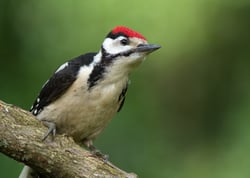 Greater Spotted Woodpecker
Greater Spotted Woodpecker
What are woodpeckers?
To better understand why woodpeckers may peck away at your house, it’s important to understand woodpeckers as a species. Woodpeckers are a type of bird that belongs to the family Picidae, which includes over 200 species. They are known for their unique behavior of pecking on trees and other wooden surfaces using their specialized bills to search for insects, excavate nesting cavities, and communicate with other woodpeckers.
Woodpeckers are known for their distinctive appearance, which typically includes a strong, pointed beak, a stiff tail used for balance, and unique coloration and pattern on their feathers. Most woodpeckers have zygodactyl feet, which means they have two toes facing forward and two toes facing backward, helping them cling to trees and vertical surfaces. This allows them to maintain stability when drilling into trees or other wooden surfaces.
Woodpeckers are found in various habitats around the world, including forests, woodlands, and savannas. In the United States alone, there are approximately 22 species of woodpeckers that are known to occur either as permanent residents or migratory visitors. Woodpeckers have a varied diet that consists primarily of insects but also includes fruits, nuts, and sap. They’re also well-known for their drumming behavior, where they rapidly peck on trees to create loud and distinct sounds used for communication and territorial defense.
Woodpeckers play an important role in ecosystems as they help control insect populations and create cavities in trees that are used by other birds and animals for nesting. However, some woodpecker species can also cause damage to human structures, such as buildings and utility poles, by pecking on them in search of insects or for territorial reasons.
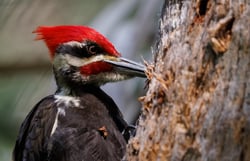 Pileated Woodpecker
Pileated Woodpecker
What kind of damage can woodpeckers cause to my home?
Woodpeckers, while beautiful birds, can sometimes cause damage to homes and other structures. The specific damage caused by woodpeckers can vary depending on the species, location, and behavior of the birds, as well as the type of structure they are targeting. Some potential damages caused by woodpeckers to homes include:
- Pecking and drilling holes: Woodpeckers have strong beaks that they use to peck and drill holes in wooden surfaces, such as siding, fascia boards, trim, and eaves. These holes can vary in size and depth depending on the species of woodpecker and their behavior. The holes that woodpeckers drill may be used for foraging or creating nesting cavities.
- Structural damage: Repeated pecking and drilling by woodpeckers can result in structural damage to the wooden components of a home, such as weakening the integrity of the siding or trim. Over time, this can lead to degradation and may require repairs or replacements.
- Noise disturbance: Woodpeckers can create loud drumming noises when they peck on a home, which can be disruptive and annoying, especially if the pecking occurs early in the morning or late in the evening. This can cause disturbance and discomfort for homeowners. A woodpecker’s drilling can be so loud that it has been compared to living next to a construction zone!
- Nesting in undesirable locations: Some woodpeckers may choose to excavate nesting cavities in undesirable locations, such as the siding or trim of a home, which can result in damage and may require repairs.
- Sap damage: Certain woodpecker species, such as the Yellow-bellied Sapsucker, may drill holes in trees or wooden surfaces to feed on sap, which can result in oozing sap and staining on the surface of the wood, as well as attract other pests like insects.
It's important to note that woodpeckers are protected under the Migratory Bird Treaty Act in the United States, which makes it illegal to harm or kill them without proper permits. If you are experiencing issues with woodpeckers causing damage to your home, it's recommended to consult with a wildlife professional to determine the best course of action, which may include using deterrents or making modifications to the structure to prevent further damage while ensuring the birds are not harmed. Intentionally harming or killing a woodpecker without necessary permits may result in a $500 fine and up to 6 months in jail.
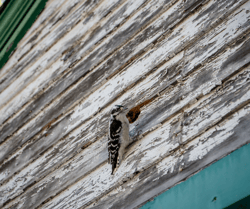 Woodpecker drilling into wood siding
Woodpecker drilling into wood siding
Why do woodpeckers peck homes?
Woodpeckers may peck at houses and other structures for various reasons, which can include:
- Foraging: Woodpeckers are primarily insectivorous, and they may peck at houses to search for insects or other arthropods that may be hiding in the wood or crevices of the structure. They use their strong beaks to create holes and excavate insect galleries, which can provide them with a food source. This is especially common in homes with carpenter bee infestations as woodpeckers are attracted to the carpenter bee’s larva.
- Drumming: Woodpeckers also engage in drumming behavior, where they peck on surfaces to communicate, establish territory, or attract a mate. This drumming behavior can sometimes lead woodpeckers to peck at houses, as the resonant sound produced by drumming on certain surfaces, such as wood siding or metal flashing, can be particularly loud and attention-grabbing. Unfortunately for homeowners, this same drumming can be a source of headaches and frustration.
- Nesting: Some woodpecker species, such as the Northern Flicker and the Red-bellied Woodpecker, excavate nesting cavities in trees or wooden structures, including houses. They may peck at the wood to create a cavity for nesting, which can result in holes being made in the structure.
- Seeking shelter: Woodpeckers may also peck at houses in search of shelter from adverse weather conditions or predators. They may create holes to roost or seek refuge from extreme temperatures, rain, or wind.
It's important to note that woodpeckers do not peck at houses out of malice or with the intent to cause damage. Their behavior is driven by natural instincts for foraging, communication, and nesting. However, the pecking behavior of woodpeckers can sometimes result in damage to houses, which may require appropriate mitigation measures to prevent further damage while ensuring the woodpeckers are not harmed.
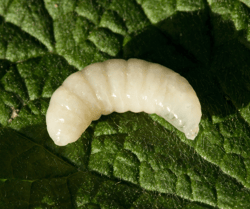 Carpenter bee larvae
Carpenter bee larvae
How can I prevent woodpeckers from pecking at my home?
Understandably, you may be wondering how you can prevent the unpleasant experience of a woodpecker taking up residence at your home. While difficult to prevent entirely, some homes may be at inherent risk of a visit from a woodpecker due to its location, construction type, and accessibility. That said, there are a few woodpecker prevention methods that may protect your home. These include:
- Install visual deterrents: Woodpeckers are often scared away by visual stimuli that they perceive as threatening. You can use reflective or shiny objects, such as Mylar tape, aluminum foil strips, or CDs, hung or attached to the areas where woodpeckers are pecking. These reflective surfaces can create flashes of light that may deter woodpeckers from approaching your house.
- Use auditory deterrents: Loud noises or sounds that mimic distress calls of other birds or predators can also deter woodpeckers. You can use devices such as motion-activated alarms, whistles, or bird distress calls to create noise or mimic predator sounds in the vicinity of the woodpecker activity.
- Modify the habitat: Woodpeckers are attracted to homes that provide food or shelter. Removing potential food sources, such as insects or other prey, from around your house can reduce woodpecker foraging behavior. A reputable pest control company like EcoShield can help ensure there are no food woodpecker food sources in or around your home. You can also remove any dead trees or decaying wood near your house, as these can attract woodpeckers for nesting or foraging.
- Install physical barriers: Physical barriers can be used to prevent woodpeckers from accessing the areas they are pecking. For example, you can install mesh netting, bird spikes, or woodpecker nest boxes in strategic locations to deter woodpeckers from pecking on your house.
- Apply taste or scent repellents: Some taste or scent repellents, such as commercial woodpecker repellent sprays or homemade remedies like hot pepper spray, can be applied to the wood surfaces of your house to make them unpalatable or unpleasant for woodpeckers.
- Seek professional help: If you are facing persistent woodpecker damage to your house, it's advisable to consult with a wildlife professional who can assess the situation and provide tailored recommendations based on the specific circumstances. They may suggest additional techniques or products that are effective in deterring woodpeckers. We do not recommend DIY attempts at woodpecker removal as they are heavily protected by the Migratory Bird Treaty Act.
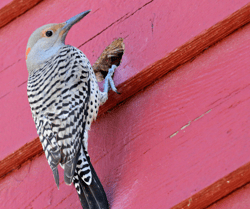 Woodpecker on barn exterior
Woodpecker on barn exterior
Can EcoShield help me prevent woodpeckers?
Yes!
Many woodpeckers are drawn to homes because of the potential food sources available to them. Luckily, EcoShield can help eradicate the pests that may attract woodpeckers with our Shield Home Service or Carpenter Bee Shield Service. A variety of insects around your home may draw woodpeckers near, including carpenter bees and their larva, termites, bark beetles, ants, spiders, caterpillars, crickets, and grasshoppers. By removing a woodpecker’s potential food source, EcoShield can help create an environment that is less appealing and hospitable for our feathered friends.
Protecting your home from pests can offer a defense against a multitude of other wildlife, including woodpeckers. Give EcoShield a call or fill out the form on this page to shield your home from unwanted pests today!